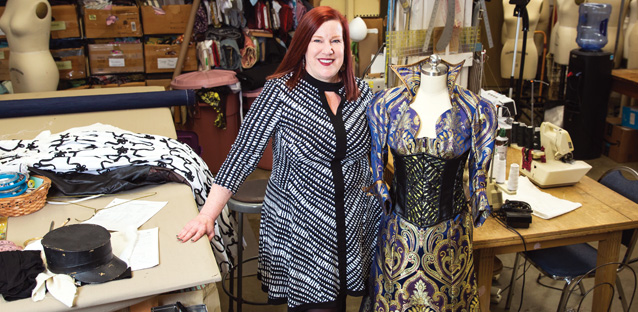Professor Anne Toewe, Ph.D., studies Victorian mourning mores and steampunk, and puts her extensive clothing history research to use in costume design for UNC mainstage productions and in the classroom.
You have shiny gold or silver buttons, replace them with dully buffed glass.
You see a widow you know at the market, shopping in her black dress; don’t approach her for a chat unless she approaches you.
You’re a woman mourning your husband: make sure every item of clothing is black for at least three years.
Your wife dies. Prove your love by wrapping your hat band with black crepe. Oh, another
widower wraps a taller hat? Buy a hat the height of a train car to prove you loved
your wife more.
These are a few of the rules and anecdotes of mourning in the Victorian era, and no one knows them like Theatre Professor Anne M. Toewe, Ph.D., costume designer and head of the Theatre Design and Technology program at UNC.
Her research on Victorian mourning took her to London in the fall of 2019 to present at the International Conference of Dress Historians, where she shared her research on Victorian mourning rules, especially for men. She found they are not any less codified than rules for women, but the mourning periods are typically shorter, as men were more likely to need to remarry to keep their households functioning. (Her presentation, “Men’s Victorian Mourning Practices in America” was published in the Summer 2020 edition of the “Journal of Dress History” and will be published as a chapter in the upcoming book from the Association of Dress Historians devoted to Victorian history.) Toewe is also a contributing researcher with the University of Leeds on Frederic Forster’s Mourning Warehouse, along with Lou Taylor, a prominent scholar on mourning practices in Europe.
Toewe’s work as a clothing historian and fashion designer melds on stage and in the classroom, where she immerses her students in clothing history — a set of binders from each historical era spans half of her office — and then sets them to work using research to design costumes.
Toewe herself designs five to 10 mainstage UNC productions each year. In 2014, when the university staged Sweeney Todd: The Demon Barber of Fleet Street, director David Grapes came to Toewe with a request: To outfit the actors in steampunk garb, playing off the 1980s subculture born from sci-fi and alternate history literature.
Then, when Grapes directed George Bernard Shaw’s Major Barbara in 2017, he asked for steampunk again. This time, Toewe dug into the scholarly roots of the genre and found something surprising about steampunk subculture adherents.
“There are a lot of them out there that are incredibly studied in Victorian social practices. They’ve just found a way to bring that to life,” she says. “Say you’re not allowed to wear black. ‘Oh, well then, I’m going to make my costume black.’ ‘My corset goes on the outside.’ Which would be completely inappropriate for Victorians. ‘I’m going to have three quarter sleeves.’ What? Your arms are showing in the daytime?”
Toewe studied Biology as an undergraduate and went into costume design after looking for an easy “A” led her to a Costume Construction class at the College of William and Mary, which she took to boost her GPA for medical school. And that turned into another costume class. And another. She went on to earn a Master of Fine Arts — a terminal degree in the field — and became a professional costume designer, working around the country.
She entered the University of Colorado’s Ph.D. program (to prove to a boyfriend that Ph.D. programs weren’t that hard to get into), but found it filled the gaps left by her nontraditional academic route (as well as getting “Dr.” into her name — she’s from a long line of medical doctors). Toewe came to UNC for three years but has stayed 19, having found a love for research and teaching. She attributes her passion to her mentor in those undergraduate classes, and that’s partly why she’s a teacher now. On that note, she says research is a way to develop as a professional while still being available to her undergraduates, rather than leaving campus for weeks at a time to go design other shows.
Costume history is a great way to learn history, Toewe says. An understanding of culture gives context to clothing, and clothing trends are a way to remember dates. She pushes her students to have extensive information on file in their brains for when a director makes a spur-of-the-moment request or comment in a meeting.
“Rumor has it that my Costume History class is the second hardest class on the college campus. Second only to Physics,” she says. “Well, I mean, 20,000 years of fashion in 16 weeks is a lot.”
In addition to helping make her tough, her Biology degree has not gone to waste.
“Everything I learned as a biologist, looking down the tube of a microscope, in terms of layers of observation, scholarly study, detail, is what I do now,” she says. She jokes that she can’t be an impartial juror because she would notice and judge every detail of a defendant and prosecutor. “I am a scientist. I’m just a scientist of clothing, of fashion, of historical time periods, of mores and social cultures.”
—By Rebecca O’Brien


